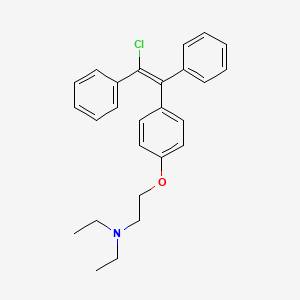
Synopsis
Synopsis
0
USDMF
0
CEP/COS
0
JDMF
0
EU WC
0
KDMF
0
VMF
0
EDQM
0
USP
0
JP
0
Others
0
FDF Dossiers
0
FDA Orange Book

0
Europe

0
Canada

0
Australia

0
South Africa

0
Listed Dossiers
DRUG PRODUCT COMPOSITIONS
0
US Patents
0
US Exclusivities
0
Health Canada Patents
US Medicaid
NA
Annual Reports
NA
Regulatory FDF Prices
NA
0
API
0
FDF
0
Data Compilation #PharmaFlow
0
Stock Recap #PipelineProspector
0
Weekly News Recap #Phispers
0
News #PharmaBuzz


1. Enclomifene
2. En-clomiphene
3. Enclomiphen
4. (e)-2-(p-(2-chloro-1,2-diphenylvinyl)phenoxy)triethylamine
5. Trans-clomiphene
1. Trans-clomiphene
2. Enclomifene
3. 15690-57-0
4. Trans-clomifene
5. Enclomifeno
6. Enclomifenum
7. Isomer B
8. Rmi 16,289
9. Isomer-b
10. R6d2ui4fls
11. Ici 46476
12. Rmi-16,289
13. (e)-2-(p-(2-chloro-1,2-diphenylvinyl)phenoxy)triethylamine
14. Ici-46476
15. Rmi-16289
16. Dtxsid201318048
17. Trans-2-(4-(2-chloro-1,2-diphenylethenyl)phenoxy)-n,n-diethylethanamine
18. Ethanamine, 2-(4-(2-chloro-1,2-diphenylethenyl)phenoxy)-n,n-diethyl-, (e)-
19. Enclomiphen
20. En-clomiphene
21. Trans Clomiphene
22. 2-(4-((e)-2-chloro-1,2-di(phenyl)ethenyl)phenoxy)-n,n-diethylethanamine
23. 2-[4-[(e)-2-chloro-1,2-di(phenyl)ethenyl]phenoxy]-n,n-diethylethanamine
24. Clomiphene Trans-
25. Refchem:136761
26. Dtxcid50196644
27. (2-(4-((e)-2-chloro-1,2-diphenylethenyl)phenoxy)ethyl)diethylamine
28. Clomifene
29. Enclomiphene [usan]
30. Cisclomiphene
31. Enclomifene [inn]
32. Clomiphene Trans-form
33. Ethanamine, 2-[4-[(1e)-2-chloro-1,2-diphenylethenyl]phenoxy]-n,n-diethyl-
34. 2-[4-[(e)-2-chloro-1,2-diphenylethenyl]phenoxy]-n,n-diethylethanamine
35. Clomifeno
36. Enclomiphene (usan)
37. Transclomifenum
38. Clomifenum
39. 2-[4-[(e)-2-chloro-1,2-diphenyl-vinyl]phenoxy]-n,n-diethyl-ethanamine
40. Enclomifenum [inn-latin]
41. Enclomifeno [inn-spanish]
42. Clomiphene Citrate (z,e)
43. Unii-r6d2ui4fls
44. 2-{4-[(e)-2-chloro-1,2-diphenylethenyl]phenoxy}-n,n-diethylethanamine
45. Trans-enclomiphene
46. Clomifene (tn)
47. Clomifene (inn)
48. Ncgc00179503-02
49. 53q
50. Trans-2-(p-(2-chloro-1,2-diphenylvinyl)phenoxy)triethylamine
51. Prestwick2_000397
52. Prestwick3_000397
53. Chembl954
54. Schembl34893
55. Bspbio_000613
56. Mls001304092
57. Mls006011852
58. Bidd:er0223
59. Bidd:gt0216
60. Enclomiphene [who-dd]
61. {2-[4-(2-chloro-1,2-diphenylethenyl)phenoxy]ethyl}diethylamine
62. 2-(4-(2-chloro-1,2-diphenylethenyl)phenoxy)-n,n-diethylethanamine
63. 2-[4-(2-chloro-1,2-diphenylethenyl)phenoxy]-n,n-diethylethanamine
64. Bpbio1_000675
65. Gtpl7619
66. Bdbm55354
67. Cid_1548953
68. Cid_6420009
69. Hms2090o17
70. Hms2232e06
71. Clomiphene Trans-form [mi]
72. Mfcd00867469
73. Stk525981
74. Triethylamine, 2-(p-(2-chloro-1,2-diphenylvinyl)phenoxy)-, (e)-
75. Akos005459442
76. Db06735
77. Ncgc00179503-01
78. Ncgc00179503-12
79. Da-63191
80. Smr000718756
81. Smr004703502
82. Hy-118861
83. Cs-0069846
84. Ns00121637
85. C06917
86. D07726
87. D08910
88. H20724
89. 911c455
90. Brd-k04218075-048-03-4
91. 1-(p-.beta.-diethylaminoethoxyphenyl)-1,2-diphenyl-2-chloroethylene
92. 1-[(e)-2-chloro-1,2-diphenylethenyl]-4-methoxybenzene; Clomiphene
93. 2-{4-[(e)-2-chloro-1,2-diphenylethenyl]phenoxy}-n,n-diethylethan-1-amine
| Molecular Weight | 406.0 g/mol |
|---|---|
| Molecular Formula | C26H28ClNO |
| XLogP3 | 7.2 |
| Hydrogen Bond Donor Count | 0 |
| Hydrogen Bond Acceptor Count | 2 |
| Rotatable Bond Count | 9 |
| Exact Mass | Da |
| Monoisotopic Mass | Da |
| Topological Polar Surface Area | 12.5 |
| Heavy Atom Count | 29 |
| Formal Charge | 0 |
| Complexity | 481 |
| Isotope Atom Count | 0 |
| Defined Atom Stereocenter Count | 0 |
| Undefined Atom Stereocenter Count | 0 |
| Defined Bond Stereocenter Count | 1 |
| Undefined Bond Stereocenter Count | 0 |
| Covalently Bonded Unit Count | 1 |
Used mainly in female infertility due to anovulation (e.g. due to polycystic ovary syndrome) to induce ovulation.
Estrogen Antagonists
Compounds which inhibit or antagonize the action or biosynthesis of estrogenic compounds.
Fertility Agents, Female
Compounds which increase the capacity to conceive in females.
Selective Estrogen Receptor Modulators
A structurally diverse group of compounds distinguished from ESTROGENS by their ability to bind and activate ESTROGEN RECEPTORS but act as either an agonist or antagonist depending on the tissue type and hormonal milieu. They are classified as either first generation because they demonstrate estrogen agonist properties in the ENDOMETRIUM or second generation based on their patterns of tissue specificity. (Horm Res 1997;48:155-63)
G - Genito urinary system and sex hormones
G03 - Sex hormones and modulators of the genital system
G03G - Gonadotropins and other ovulation stimulants
G03GB - Ovulation stimulants, synthetic
G03GB02 - Clomifene
ATCvet Code
QG - Genito urinary system and sex hormones
QG03 - Sex hormones and modulators of the genital system
QG03G - Gonadotropins and other ovulation stimulants
QG03GB - Ovulation stimulants, synthetic
QG03GB02 - Clomifene
G03GB02
Absorption
Based on early studies with 14 C-labeled clomifene, the drug was shown to be readily absorbed orally in humans.
Route of Elimination
Based on early studies with 14C-labeled clomiphene citrate, the drug was shown to be readily absorbed orally in humans and excreted principally in the feces. Mean urinary excretion was approximately 8% with fecal excretion of about 42%.
Hepatic
5-7 days
Clomifene has both estrogenic and anti-estrogenic properties, but its precise mechanism of action has not been determined. Clomifene appears to stumulate the release of gonadotropins, follicle-stimulating hormone (FSH), and leuteinizing hormone (LH), which leads to the development and maturation of ovarian follicle, ovulation, and subsequent development and function of the coprus luteum, thus resulting in pregnancy. Gonadotropin release may result from direct stimulation of the hypothalamic-pituitary axis or from a decreased inhibitory influence of estrogens on the hypothalamic-pituitary axis by competing with the endogenous estrogens of the uterus, pituitary, or hypothalamus. Clomifene has no apparent progestational, androgenic, or antrandrogenic effects and does not appear to interfere with pituitary-adrenal or pituitary-thyroid function.
ABOUT THIS PAGE
